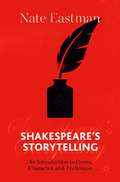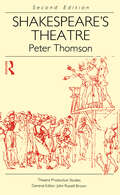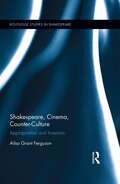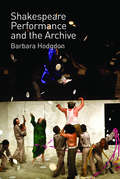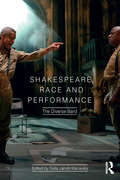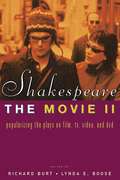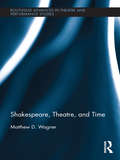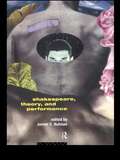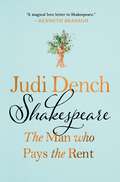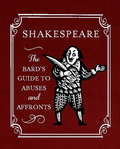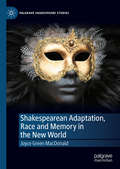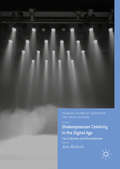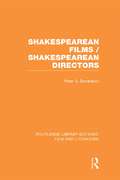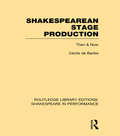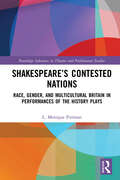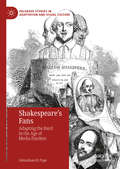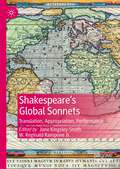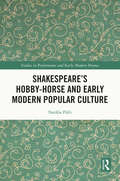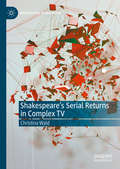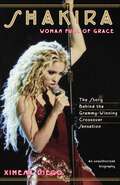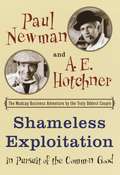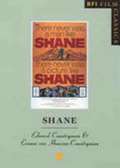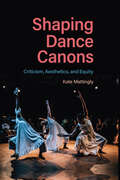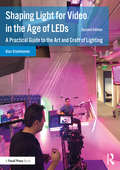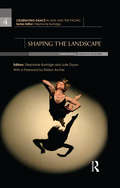- Table View
- List View
Shakespeare's Storytelling: An Introduction to Genre, Character, and Technique
by Nate EastmanShakespeare’s Storytelling: An Introduction to Genre, Character, and Technique is a textbook focused on specific storytelling techniques and genres that Shakespeare invented or refined. Drawing on examples from popular novels, plays, and films (such as IT, Beloved, Sex and the City, The Godfather, and Fences) the book provides an overview of how Shakespearean storytelling techniques including character flaws, conflicts, symbols, and more have been adapted by later writers and used in the modern canon. Rather than taking a historicist or theoretical approach, Nate Eastman uses recognizable references and engaging language to teach the concepts and techniques most applicable to the future study of Creative Writing, English, Theater, and Film and Media. Students will be prepared to interpret Shakespeare’s plays and understand Shakespeare as the beginning of a literary tradition. A readable introduction to Shakespeare and his significance, this book is suitable for undergraduates.
Shakespeare's Theatre (Theatre Production Studies)
by Peter ThomsonReviews of the First Edition `...valuable and enjoyable reading for all studying Shakespeare's plays.' Following in the patternestablished by John Russell Brown for the excellent series (Theatre and Production Studies), he provides first an account of Shakespeare's company, then a study of three individual plays Twelfth Night, Hamlet and Macbeth as performed by the company. Peter Thomson writes in a crisp, sharp, enlivening style.' TLS '`...the best analysis yet of Elizabethan acting practices, excavated form the texts themselves rather than reconstructed on basis of one monolithic theory, and an essay on Hamlet that is a model of Critical intelligence and theatrical invention.' Yearbook of English Studies `Synthesizes the important facts and summarizes projects with a vigorous prose style, and expertly applies his experience in both practical drama and academic teaching to his discussion.' Review of English Studies
Shakespeare, Cinema, Counter-Culture: Appropriation and Inversion (Routledge Studies in Shakespeare #17)
by Ailsa Grant FergusonAddressing for the first time Shakespeare’s place in counter-cultural cinema, this book examines and theorizes counter-hegemonic, postmodern, and post-punk Shakespeare in late 20th and early 21st century film. Drawing on a diverse range of case studies, Grant Ferguson presents an interdisciplinary approach that offers new theories on the nature and application of Shakespearean appropriations in the light of postmodern modes of representation. The book considers the nature of the Shakespearean inter-text in subcultural political contexts concerning the politicized aesthetics of a Shakespearean ‘body in pieces,’ the carnivalesque, and notions of Shakespeare as counter-hegemonic weapon or source of empowerment. Representative films use Shakespeare (and his accompanying cultural capital) to challenge notions of capitalist globalization, dominant socio-cultural ideologies, and hegemonic modes of expression. In response to a post-modern culture saturated with logos and semiotic abbreviations, many such films play with the emblematic imagery and references of Shakespeare’s texts. These curious appropriations have much to reveal about the elusive nature of intertextuality in late postmodern culture and the battle for cultural ownership of Shakespeare. As there has yet to be a study that isolates and theorizes modes of Shakespearean production that specifically demonstrate resistance to the social, political, ideological, aesthetic, and cinematic norms of the Western world, this book expands the dialogue around such texts and interprets their patterns of appropriation, adaptation, and representation of Shakespeare.
Shakespeare, Performance and the Archive
by Barbara HodgdonShakespeare, Performance and the Archive is a ground-breaking and movingly written exploration of what remains when actors evacuate the space and time of performance. An analysis of ‘leftovers’, it moves between tracking the politics of what is consciously archived and the politics of visible and invisible theatrical labour to trace the persistence of performance. In this fascinating volume, Hodgdon considers how documents, material objects, sketches, drawings and photographs explore scenarios of action and behaviour – and embodied practices. Rather than viewing these leftovers as indexical signs of a theatrical past, Hodgdon argues that the work they do is neither strictly archival nor documentary but performative – that is, they serve as sites of re-performance. Shakespeare, Performance and the Archive creates a deeply materialized historiography of performance and attempts to make that history do something entirely new. Barbara Hodgdon is Professor of English at the University of Michigan, now retired. Her major interest is in theatrical performances, especially performed Shakespeare. She is the author of: The End Crowns All, The Shakespeare Trade, and most recently the Arden edition of The Taming of the Shrew.
Shakespeare, Race and Performance: The Diverse Bard
by Delia Jarrett-MacauleyWhat does it mean to study Shakespeare within a multicultural society? And who has the power to transform Shakespeare? The Diverse Bard explores how Shakespeare has been adapted by artists born on the margins of the Empire, and how actors of Asian and African-Caribbean origin are being cast by white mainstream directors. It examines how notions of 'race' define the contemporary British experience, including the demands of traditional theatre, and it looks at both the playtexts themselves and contemporary productions. Editor Delia Jarrett-Macauley assembles a stunning collection of classic texts and new scholarship by leading critics and practitioners, to provide the first comprehensive critical and practical analysis of this field.
Shakespeare, The Movie II: Popularizing the Plays on Film, TV, Video and DVD
by Richard Burt Lynda E. BooseFollowing on from the phenomenally successful Shakespeare, The Movie, this volume brings together an invaluable new collection of essays on cinematic Shakespeares in the 1990s and beyond. Shakespeare, The Movie II:*focuses for the first time on the impact of postcolonialism, globalization and digital film on recent adaptations of Shakespeare;*takes in not only American and British films but also adaptations of Shakespeare in Europe and in the Asian diapora;*explores a wide range of film, television, video and DVD adaptations from Almereyda's Hamlet to animated tales, via Baz Luhrmann, Kenneth Branagh, and 1990s' Macbeths, to name but a few;*offers fresh insight into the issues surrounding Shakespeare on film, such as the interplay between originals and adaptations, the appropriations of popular culture, the question of spectatorship, and the impact of popularization on the canonical status of "the Bard."Combining three key essays from the earlier collection with exciting new work from leading contributors, Shakespeare, The Movie II offers sixteen fascinating essays. It is quite simply a must-read for any student of Shakespeare, film, media or cultural studies.
Shakespeare, Theatre, and Time (Routledge Advances in Theatre & Performance Studies #20)
by Matthew WagnerThat Shakespeare thematized time thoroughly, almost obsessively, in his plays is well established: time is, among other things, a 'devourer' (Love's Labour's Lost), one who can untie knots (Twelfth Night), or, perhaps most famously, simply ‘out of joint’ (Hamlet). Yet most critical commentary on time and Shakespeare tends to incorporate little focus on time as an essential - if elusive - element of stage praxis. This book aims to fill that gap; Wagner's focus is specifically performative, asking after time as a stage phenomenon rather than a literary theme or poetic metaphor. His primary approach is phenomenological, as the book aims to describe how time operates on Shakespearean stages. Through philosophical, historiographical, dramaturgical, and performative perspectives, Wagner examines the ways in which theatrical activity generates a manifest presence of time, and he demonstrates Shakespeare’s acute awareness and manipulation of this phenomenon. Underpinning these investigations is the argument that theatrical time, and especially Shakespearean time, is rooted in temporal conflict and ‘thickness’ (the heightened sense of the present moment bearing the weight of both the past and the future). Throughout the book, Wagner traces the ways in which time transcends thematic and metaphorical functions, and forms an essential part of Shakespearean stage praxis.
Shakespeare, Theory and Performance
by James C. BulmanShakespeare, Theory and Performance is a groundbreaking collection of seminal essays which apply the abstract theory of Shakespearean criticism to the practicalities of performance. Bringing together the key names from both realms, the collection reflects a wide range of sources and influences, from traditional literary, performance and historical criticism to modern cultural theory. Together they raise questions about the place of performance criticism in modern and often competing debates of cultural materialism, new historicism, feminism and deconstruction. An exciting and fascinating volume, it will be important reading for students and scholars of literary and theatre studies alike.
Shakespeare, or, The Man Who Pays the Rent
by Judi Dench Brendan O'HeaTaking a curtain call with a live snake in her wig... Cavorting naked through the Warwickshire countryside painted green... <P> Acting opposite a child with a pumpkin on his head... <P> These are just a few of the things Dame Judi Dench has done in the name of Shakespeare. <P><P> For the very first time, Judi opens up about every Shakespearean role she has played throughout her seven-decade career, from Lady Macbeth and Titania to Ophelia and Cleopatra. In a series of intimate conversations with actor & director Brendan O'Hea, she guides us through Shakespeare's plays with incisive clarity, revealing the secrets of her rehearsal process and inviting us to share in her triumphs, disasters, and backstage shenanigans. <P><P> Interspersed with vignettes on audiences, critics, company spirit and rehearsal room etiquette, she serves up priceless revelations on everything from the craft of speaking in verse to her personal interpretations of some of Shakespeare's most famous scenes, all brightened by her mischievous sense of humour, striking level of honesty and a peppering of hilarious anecdotes, many of which have remained under lock and key until now. <P><P> Instructive and witty, provocative and inspiring, this is ultimately Judi's love letter to Shakespeare, or rather, The Man Who Pays The Rent. <p> <b>New York Times Bestseller</b>
Shakespeare: The Bard's Guide to Abuses and Affronts (RP Minis)
by Edited by Nancy ArmstrongPresenting a most civilized way to silence boors, deflect rudeness, and chide churlish lovers: Our mini book of insults culled from the dramatic works of English literature's most gifted wordsmith. Shakespeare's enduring putdowns include "Thou art a very ragged Wart" (Henry IV), "Thy kiss is as comfortless as frozen water to a starved snake" (Troilus and Cressida), and "In civility thou seem'st so empty" (As You Like It). Why resort to vulgarity when a high-brow literary epithet does the job so well?
Shakespearean Adaptation, Race and Memory in the New World (Palgrave Shakespeare Studies)
by Joyce Green MacDonaldAs readers head into the second fifty years of the modern critical study of blackness and black characters in Renaissance drama, it has become a critical commonplace to note black female characters’ almost complete absence from Shakespeare’s plays. Despite this physical absence, however, they still play central symbolic roles in articulating definitions of love, beauty, chastity, femininity, and civic and social standing, invoked as the opposite and foil of women who are “fair”. Beginning from this recognition of black women’s simultaneous physical absence and imaginative presence, this book argues that modern Shakespearean adaptation is a primary means for materializing black women’s often elusive presence in the plays, serving as a vital staging place for historical and political inquiry into racial formation in Shakespeare’s world, and our own. Ranging geographically across North America and the Caribbean, and including film and fiction as well as drama as it discusses remade versions of Othello, Romeo and Juliet, Antony and Cleopatra, and The Taming of the Shrew, Shakespearean Adaptation, Race, and Memory in the New World will attract scholars of early modern race studies, gender and performance, and women in Renaissance drama.
Shakespearean Celebrity in the Digital Age: Fan Cultures and Remediation (Palgrave Studies in Adaptation and Visual Culture)
by Anna BlackwellThis book offers a timely examination of the relationship between Shakespeare and contemporary digital media. By focusing upon a variety of ‘Shakespearean’ individuals, groups and communities and their ‘online’ presence, the book explores the role of popular internet culture in the ongoing adaptation of Shakespeare’s plays and his general cultural standing. The description of certain performers as ‘Shakespearean’ is a ubiquitous but often throwaway assessment. However, a study of ‘Shakespearean’ actors within a broader cultural context reveals much, not only about the mutable face of British culture (popular and ‘highbrow’) but also about national identity and commerce. These performers share an online space with the other major focus of the book: the fans and digital content creators whose engagement with the Shakespearean marks them out as more than just audiences and consumers; they become producers and critics. Ultimately, Digital Shakespeareans moves beyond the theatrical history focus of related works to consider the role of digital culture and technology in shaping Shakespeare’s contemporary adaptive legacy and the means by which we engage with it.
Shakespearean Films/Shakespearean Directors (Routledge Library Editions: Film and Literature)
by Peter S. DonaldsonOriginally published in 1990, this book brought a new rigor and subtlety to the interpretation of film adaptations of Shakespeare. Drawing on traditional literary analysis, psychoanalysis, and current film theory about gender and subjectivity, the author combines close readings of seven films with historical and biographical studies of the directors who made them. Offering substantial readings of Jean-Luc Godard’s controversial deconstructed King Lear and of Liz White’s independent African-American Othello, Donaldson also applies his provocative and contemporary point of view to more familiar films. He reads Olivier’s Henry V in relation to its treatment of sexual difference; Olivier’s Hamlet in part as an expression of the director’s childhood sexual trauma; Kurosawa’s Throne of Blood as an allegory of the relationship between Western and Japanese cinema; and Zeffirelli’s immensely popular Romeo and Juliet in the light of its powerful homoerotic subtext. With striking perspectives on Shakespeare, on the movies as an expressive medium, and on the complex processes of cultural change, this is timeless useful reading for teachers and students of film and literature.
Shakespearean Stage Production: Then and Now (Routledge Library Editions: Shakespeare in Performance #3)
by Cécile De BankeAn absorbing and original addition to Shakespeareana, this handbook of production is for all lovers of Shakespeare whether producer, player, scholar or spectator. In four sections, Staging, Actors and Acting, Costume, Music and Dance, it traces Shakespearean production from Elizabethan times to the 1950s when the book was originally published. This book suggests that Shakespeare should be performed today on the type of stage for which his plays were written. It analyses the development of the Elizabethan stage, from crude inn-yard performances to the building and use of the famous Globe. Since the Globe saw the enactment of some of the Bard’s greatest dramas, its construction, properties, stage devices, and sound effects are reviewed in detail with suggestions on how a producer can create the same effects on a modern or reconstructed Elizabethan stage. Shakespeare’s plays were written to fit particular groups of actors. The book gives descriptions of the men who formed the acting companies of Elizabethan London and of the actors of Shakespeare’s own company, giving insights into the training and acting that Shakespeare advocated. With full descriptions and pages of reproductions, the costume section shows the types of dress necessary for each play, along with accessories and trimmings. A table of Elizabethan fabrics and colours is included. The final section explores the little-known and interesting story of the integral part of music and dance in Shakespeare’s works. Scene by scene the section discusses appropriate music or song for each play and supplies substitute ideas for Elizabethan instruments. Various dances are described – among them the pavan, gailliard, canary and courante. This book is an invaluable wealth of research, with extensive bibliographies and extra information.
Shakespeare’s Contested Nations: Race, Gender, and Multicultural Britain in Performances of the History Plays (Routledge Advances in Theatre & Performance Studies)
by L. Monique PittmanShakespeare’s Contested Nations argues that performances of Shakespearean history at British institutional venues between 2000 and 2016 manifest a post-imperial nostalgia that fails to tell the nation’s story in ways that account for the agential impact of women and people of color, thus foreclosing promising opportunities to re-examine the nation’s multicultural past, present, and future in more intentional, self-critical, and truly progressive ways. A cluster of interconnected stage and televisual performances and adaptations of the history play canon illustrate the function that Shakespeare’s narratives of incipient "British" identities fulfill for the postcolonial United Kingdom. The book analyzes treatments of the plays in a range of styles—staged performances directed by Michael Boyd with the Royal Shakespeare Company (2000–2001) and Nicholas Hytner at the National Theatre (2003, 2005), the BBC’s Hollow Crown series (2012, 2016), the RSC and BBC adaptations of Wolf Hall and Bring Up the Bodies (2013, 2015), and a contemporary reinterpretation of the canon, Mike Bartlett’s King Charles III (2014, 2017). This book will be of great interest to scholars and students of Shakespeare, theatre, and politics.
Shakespeare’s Fans: Adapting the Bard in the Age of Media Fandom (Palgrave Studies in Adaptation and Visual Culture)
by Johnathan H. PopeThis book examines Shakespearean adaptations through the critical lens of fan studies and asks what it means to be a fan of Shakespeare in the context of contemporary media fandom. Although Shakespeare studies and fan studies have remained largely separate from one another for the past thirty years, this book establishes a sustained dialogue between the two fields. In the process, it reveals and seeks to overcome the problematic assumptions about the history of fan cultures, Shakespeare’s place in that history, and how fan works are defined. While fandom is normally perceived as a recent phenomenon focused primarily on science fiction and fantasy, this book traces fans’ practices back to the eighteenth century, particularly David Garrick’s Shakespeare Jubilee in 1769. Shakespeare’s Fans connects historical and scholarly debates over who owns Shakespeare and what constitutes an appropriate adaptation of his work to online fan fiction and commercially available fan works.
Shakespeare’s Global Sonnets: Translation, Appropriation, Performance (Global Shakespeares)
by Jane Kingsley-Smith W. Reginald Rampone Jr.This edited collection brings together scholars from across the world, including France, Italy, Germany, Hungary, Japan, the USA and India, to offer a truly international perspective on the global reception of Shakespeare’s Sonnets from the 18th century to the present. Global Shakespeare has never been so local and familiar as it is today. The translation, appropriation and teaching of Shakespeare’s plays across the world have been the subject of much important recent work in Shakespeare studies, as have the ethics of Shakespeare’s globalization. Within this discussion, however, the Sonnets are often overlooked. This book offers a new global history of the Sonnets, including the first substantial study of their translation and of their performance in theatre, music and film. It will appeal to anyone interested in the reception of the Sonnets, and of Shakespeare across the world.
Shakespeare’s Hobby-Horse and Early Modern Popular Culture (Studies in Performance and Early Modern Drama)
by Natália PikliThis book explores the ways in which the early modern hobby-horse featured in different productions of popular culture between the 1580s and 1630s. Natália Pikli approaches this study with a thorough and interdisciplinary examination of hobby-horse references, with commentary on the polysemous uses of the word, offers an informative background to reconsider well-known texts by Shakespeare and others, and provides an overview on the workings of cultural memory regarding popular culture in early modern England. The book will appeal to those with interest in early modern drama and theatre, dramaturgy, popular culture, cultural memory, and iconography.
Shakespeare’s Serial Returns in Complex TV (Reproducing Shakespeare)
by Christina WaldThis book examines how Shakespeare’s plays resurface in current complex TV series. Its four case studies bring together The Tempest and the science fiction-Western Westworld, King Lear and the satirical dynastic drama of Succession, Hamlet and the legal thriller Black Earth Rising, as well as Coriolanus and the political thriller Homeland. The comparative readings ask what new insights the twenty-first-century remediations may grant us into Shakespeare’s texts and, vice versa, how Shakespearean returns help us understand topical concerns negotiated in the series, such as artificial intelligence, the safeguarding of democracy, terrorism, and postcolonial justice. This study also proposes that the dramaturgical seriality typical of complex TV allows insights into the seriality Shakespeare employed in structuring his plays. Discussing a broad spectrum of adaptational constellations and establishing key characteristics of the new adaptational aggregate of serial Shakespeare, it seeks to initiate a dialogue between Shakespeare studies, adaptation studies, and TV studies.
Shakira: Woman Full of Grace
by Ximena DiegoHace años que los entendidos venían pronosticando el exitoso crossover de Shakira. La cantante firmó su primer contrato discográfico a los trece años, grabó su segundo álbum a los quince y actuó en una telenovela popular en su Colombia natal. Tenía solamente diecinueve años cuando su tercer álbum, Pies descalzos, la convirtió en la artista de mayor venta en Latinoamérica. Si bien su siguiente álbum, Dónde están los ladrones?, ganó ocho discos de platino en Estados Unidos, no fue hasta su actuación electrizante en la primera entrega de los Premios Grammy Latinos que llamó la atención de todo el país. Aunque el éxito le llegó a una edad tan temprana, a los veinticuatro años Shakira tiene los pies firmes sobre la tierra y rechaza los estereotipos que rodean a las estrellas de rock. Ella es una católica devota, vive con sus padres y cuando no está grabando o de gira prefiere pasar el tiempo con su familia. Esta rockera es una de las pocas estrellas que combinan talento, carisma y sensibilidad, y que además saben muy bien lo que quieren. Para la cantante más fascinante de América Latina desde Ricky Martin, las posibilidades son ilimitadas. Para los millones de personas que ya compran sus discos, Shakira representa la voz de la nueva generación.
Shameless Exploitation in Pursuit of the Common Good: The Madcap Business Adventure by the Truly Oddest Couple
by Paul Newman A.E. Hotchner“There are three rules for running a business; fortunately, we don’t know any of them.”In 1978, Paul Newman and A. E. Hotchner decided that rather than just distribute Paul’s own salad dressing at Christmas to neighbors, they would offer it to a few local stores. Freewheeling, irreverent entrepreneurs, they conceived of their venture as a great way to poke fun at the mundane method of traditional marketing. Much to their surprise, the dressing was enthusiastically received. What had started as a lark quickly escalated into a full-fledged business, the first company to place all-natural foods in supermarkets. From salad dressing to spaghetti sauce, to popcorn and lemonade, Newman’s Own became a major player in the food business. The company’s profits were originally donated to medical research, education, and the environment, and eventually went to the creation of the eight Hole in the Wall Gang camps for children with serious illnesses. In these pages Newman and Hotchner recount the picaresque saga of their own nonmanagement adventure. In alternating voices, playing off one another in classic “Odd Couple” style, they describe how they systematically disregarded the advice of experts and relied instead on instinct, imagination, and mostly luck. They write about how they hurdled obstacle after obstacle, share their hilarious misadventures, and reveal their offbeat solutions to conventional problems. Even their approach to charity is decidedly different: every year they give away all the company’s profits, empty the coffers, and start over again. The results of this amazing generosity are brought to life in heartwarming stories about the children at their camps. With rare glimpses into their zany style and their compassion for those less fortunate, Newman and Hotchner have written the perfect nonmanagement book, at once playful, informative, and inspirational.
Shane
by Edward Countryman Evonne Von Heussen-CountrymanDirected by George Stevens, then one of Hollywood's most successful filmmakers, "Shane" (1952) is one of the most revered and imitated of all westerns. Starring Alan Ladd as a mysterious drifter who protects a fledgling community from a predatory gang, "Shane" is one of the definitive reimaginings of America's frontier mythology. This is, remarkably, the first substantial study of "Shane." In it, Edward Countryman and Evonne von Heussen-Countryman show, with reference to a wide range of historical and archival sources, how subtly the film treats some fundamental themes: family, the history of settlement and community in America, violence, and the culture of the gun.
Shaping Dance Canons: Criticism, Aesthetics, and Equity
by Kate MattinglyExamining a century of dance criticism in the United States and its influence on aesthetics and inclusion Dance criticism has long been integral to dance as an art form, serving as documentation and validation of dance performances, yet few studies have taken a close look at the impact of key critics and approaches to criticism over time. The first book to examine dance criticism in the United States across 100 years, from the late 1920s to the early twenty-first century, Shaping Dance Canons argues that critics in the popular press have influenced how dance has been defined and valued, as well as which artists and dance forms have been taken most seriously. Kate Mattingly likens the effect of dance writing to that of a flashlight, illuminating certain aesthetics at the expense of others. Mattingly shows how criticism can preserve and reproduce criteria for what qualifies as high art through generations of writers and in dance history courses, textbooks, and curricular design. She examines the gatekeeping role of prominent critics such as John Martin and Yvonne Rainer while highlighting the often-overlooked perspectives of writers from minoritized backgrounds and dance traditions. The book also includes an analysis of digital platforms and current dance projects—On the Boards TV, thINKingDANCE, Black Dance Stories, and amara tabor-smith’s House/Full of BlackWomen—that challenge systemic exclusions. In doing so, the book calls for ongoing dialogue and action to make dance criticism more equitable and inclusive.
Shaping Light for Video in the Age of LEDs: A Practical Guide to the Art and Craft of Lighting
by Alan SteinheimerA practical, hands-on guide to lighting for video, this book explores how LEDs are changing the aesthetics of lighting and provides students with an indispensable guide to the everyday techniques required to produce professional-quality lighting in the age of LEDs and wireless control options. The book focuses on first-hand application of technical knowledge, beginning with simple lighting setups and progressing to more complicated scenarios, and features accompanying diagrams, illustrations and case studies to demonstrate their real-world application. Key topics covered include basic three-point lighting, lighting moving actors, set lighting and exposure, instrument selection, bringing style to your lighting, color temperature and the Kelvin scale, exterior lighting, lighting categories and genres, green-screen techniques, money and budgeting, and electricity and electrical distribution. The book also provides guidance on career paths including what a grip does, case studies with photos and diagrams, and an extensive glossary of set terminology to introduce students to the language of filmmaking. A must-have resource for film and media production students taking classes in lighting and/or cinematography.
Shaping the Landscape: Celebrating Dance in Australia (Celebrating Dance in Asia and the Pacific)
by Stephanie Burridge; Julie DysonThis, the fourth book in the series 'Celebrating Dance in Asia and the Pacific', explores the current dance scene in Australia from a wide perspective that mirrors the creative engagement of artists with Australian culture and the landscape. It looks at Indigenous dance, choreography beyond theatre, youth and community dance, Australian dancers’ versatility and risk-taking. The comprehensive essays recount immigrant influences, the legacy of the Ballets Russes and Bodenwieser companies, dance on stage and screen, education and training and the story of Ausdance — the unique nation-wide voice and political advocacy organisation for dance.
